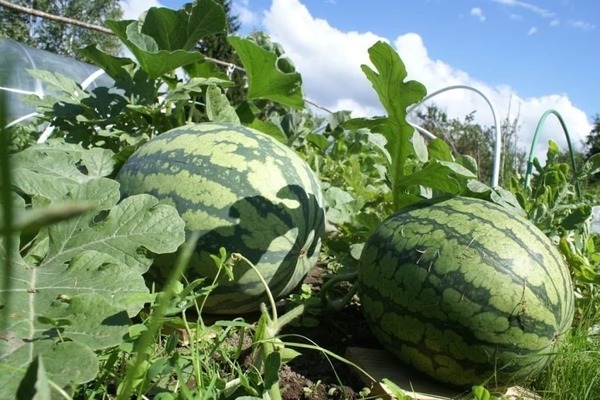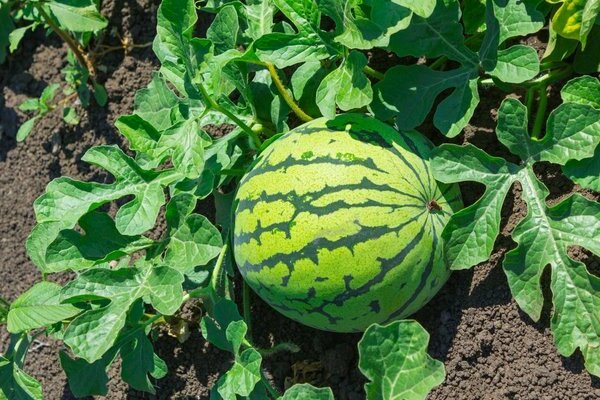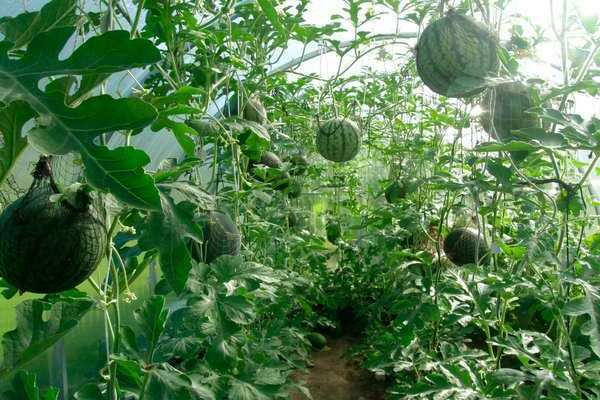Watermelon. Care, cultivation, reproduction, diseases and pests
Content:

Planting a watermelon
Watermelon is a source of magnesium necessary for the body. Another uniqueness - it does not contain acids and salts, but there are alkalis necessary for the urinary system. Due to this quality, nephrologists advise eating watermelon in sufficient quantities. With a great advantage over other berries, watermelon is used by those seeking to lose weight. Watermelon is a culture of the pumpkin family, an annual plant. The fruit looks like pulp with seeds inside the bark.
Planting watermelon: seedlings

In mid-spring (April), sow seeds in a selected container, prepare a nutrient mixture, sow 1-3 seeds, then cover with foil and try not to disturb the seedlings for the first 2-3 days. The film can be removed after the first shoots so that the seedlings do not stretch out. Seedlings love a lot of light, so if there is not enough natural light in the room, you can supplement it with special lamps. Watering is carried out with warm water, not very often, excess moisture leads to diseases and death of plants. Feeding can be done when the first 2 leaves appear.
Planting a watermelon: site preparation

When choosing a place for planting seedlings in the ground, you need to take into account shelter from harsh winds, sandy loam soil is chosen, where there is enough organic matter, without waterlogging, clean from weeds. Disembarkation usually takes place in the second half of May, so the place begins to be prepared in the first days. Put manure on the bottom of the hole and cover it with soil, covering it with a film, you can achieve a greater effect, the soil will warm up. After placing the arcs, pull the covering material.
Transplanting
Before the planting process, the soil is shed, loosened. The distance between plants is kept at least 2 meters, because of the long lashes. If the weather is sunny, hot, it is better to plant in the afternoon. If, nevertheless, the temperature is high, you can shade with a flooring. Water the wells abundantly, and cover the greenhouse with foil through the arcs. In the future, while the seedlings get stronger, do watering every 2-3 days. If there is a drought, watering more often, but do not increase the dose of water.
Planting a watermelon: care

After planting, the subsequent feeding should be done in 14 days. The second stage is after the buds appear. Mandatory watering immediately after adding fertilizer. Watering should be moderate, despite the fact that the root system is powerful and can extract water on its own from the depths. Watering should be reduced during the period of fruit development, and when ripe, it can be completely suspended. From this, the fruits will be juicier and more sweet. The direction of the branches should be along the structure adapted for the shelter to avoid strong entanglement. It is advisable to pinch the lateral shoots at the level of 4-5 leaves. After the formation of fruits, place boards or other material that does not rot in a short time under them. If there is a prolonged cloudy weather, you can carry out forced pollination, because insects are not active in this weather.
Disease control and prevention
One of the most common diseases is powdery mildew, which appears as spots on the upper and lower sides of the leaves, around the stem. Subsequently, the leaves begin to turn yellow and die off. If you do not respond in time, the disease will spread to the fetus. Only the first signs appeared, immediately spray with the infusion of the cowshed (3 days), diluted with water 1: 3. If the scale of infection is large, repeat the procedure two more times.
Oily spots, later ulcers, olive-colored speaks of the disease OLIVE SPOTS.The boundary between a healthy and diseased area is the appearance of a gelatinous fluid. As a result, the ovaries die and the fetus dies. If even small lesions are found, it is necessary to remove not only the leaves, stems, but even the fruit, without sparing.
Brown, angular spots indicate the presence of BACTERIOSIS, on fruits it appears in the form of ulcers filled with liquid. When fighting, 1% Bordeaux liquid will help.
Among the pests, spider mites and aphids (melons) are noted, causing the greatest harm by sucking juice from plants, piercing the skin. As a result, yellowing of the leaf and subsequent drying. With a large-scale lesion, the plant dies.
Alternative methods can be used as prevention. For example, ordinary chamomile is used in the form of an infusion or decoction. Uncontaminated potato tops, common dope. Carrying out the treatment prematurely, you can completely prevent infection and not harm the plant by processing with chemicals.
Watermelon is not only a delicious treat, but a storehouse of usefulness. Will be a great addition to any table at any time. And with the right approach, you can have a rich harvest, and the tips discussed in this article will be useful, especially for novice gardeners.

